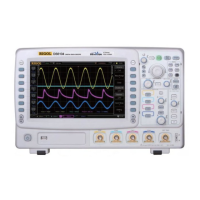RIGOL Chapter 2 Performance Verification Test
2-14 DS6000 Performance Verification Guide
4) Press CH1 BW Limit and use to select “20 M” bandwidth limit.
5) Output a sine signal with 1 MHz frequency and 1.2 Vpp amplitude via Fluke 9500B.
6) Press MENU Vrms at the left side of the screen of the oscilloscope to enable the
effective value measurement function. Read and record Vrms1.
7) Output a sine signal with 20 MHz frequency and 1.2 Vpp amplitude via Fluke 9500B.
8) Rotate HORIZONTAL
SCALE of the oscilloscope to set the horizontal time base to 20
ns.
9) Press MENU Vrms at the left side of the screen of the oscilloscope to enable the
effective value measurement function. Read and record Vrms2.
10) Calculate the amplitude loss: Amplitude Loss A1 (dB) = 20 × lg (Vrms2/Vrms1) and
compare the result with the specification. At this point, the amplitude loss should be within
the specification range.
11) Output a sine signal with 40 MHz frequency and 1.2 Vpp amplitude via Fluke 9500B.
12) Rotate HORIZONTAL
SCALE of the oscilloscope to set the horizontal time base to 10
ns.
13) Press MENU Vrms at the left side of the screen of the oscilloscope to enable the
effective value measurement function. Read and record Vrms3.
14) Calculate the amplitude loss: Amplitude Loss A2 (dB) = 20 × lg (Vrms3/Vrms1). At
this point, the amplitude loss should be lower than -3 dB.
15) Keep the other settings of the oscilloscope in step 3) unchanged and set the vertical scale to
500 mV/div.
16) Output a sine signal with 1 MHz frequency and 3 Vpp amplitude via Fluke 9500B.
17) Repeat step 6).
18) Output a sine signal with 20 MHz frequency and 3 Vpp amplitude via Fluke 9500B.
19) Repeat steps 8) to 10).
20) Output a sine signal with 40 MHz frequency and 3 Vpp amplitude via Fluke 9500B.
21) Repeat steps 12) to 14).
22) Turn off CH1. Test CH2, CH3 and CH4 respectively using the above test method and record
the test results.
2. 250 MHz Bandwidth Limit Test
1) Connect the active signal terminal of Fluke 9500B to CH1 of the oscilloscope, as shown in
the figure above.
2) Enable Fluke 9500B and set its impedance to 50 Ω.
3) Configure the oscilloscope:
a) Press CH1 in the vertical control area (VERTICAL) at the front panel to enable CH1.
b) Press CH1 Probe Ratio to set the probe attenuation ratio to “1X”.
c) Press CH1 Input to set the input impedance to 50 Ω.
d) Rotate VERTICAL SCALE to set the vertical scale to 200 mV/div.
e) Rotate HORIZONTAL SCALE to set the horizontal time base to 500 ns.
f) Press HORIZONTAL POSITION and VERTICAL POSITION respectively to
set the horizontal position and vertical position to 0.
g) Press TRIGGER LEVEL to set the trigger level to 0 V.
4) Press CH1 BW Limit and use to select “250 M” bandwidth limit.

